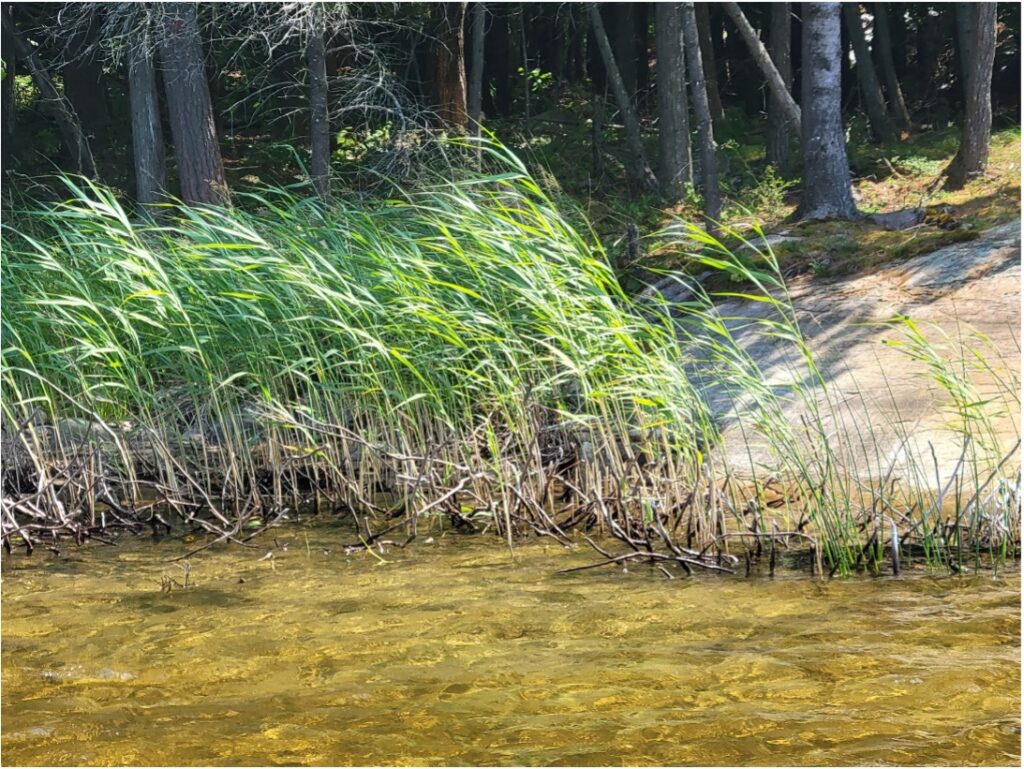By Richard Wilson
Although you may or may not know what Invasive Phragmites Australis is, you have definitely seen it. With a seemingly benign appearance, having them described to you doesn’t conjure quite the same scary notions as hearing about “Killer Hornets” or “Wild Boar”. But we should all be concerned, very concerned, about this invader.
Now thriving along most stretches of provincial 400 highways in Eastern and Southern Ontario, and equally dispersed along many secondary roads, these stands of massive (as tall as 15 feet) reeds, seem almost tranquil as they sway in the breeze. What lies beneath however is a nightmare. Thick roots, potentially the size of your wrist, can grow horizontally as much as 10 feet in a single season. Plants spread with rhizomes, stolons or seed transfer. The plants can thrive on dry land, or in water up to a metre deep. They grow so tall and dense, that in a matter of a few years, a wetland can be completely choked. Reptiles such as turtles can no longer penetrate their mass. Native bird species can’t nest in them. Surface water completely disappears through build-up of biomass and transpiration through the plants. Recreational use of infested harbours becomes a thing of the past.
The purpose of this article is not to educate you about phragmites (known as “Phrag” by many). For that please use a simple web search. The Province of Ontario and the Canadian Invasive Species Centre are two notable sites. In just a few minutes, you will read enough information to be just as worried about this threat as I am.
Southern Georgian Bay has been particularly hard hit by the infestation. Several municipalities and associations have taken up the battle, notably Georgian Bar Forever, which has been operating a phrag management and control program since 2012. Coastal stands of phrag can be combatted by cutting their stems, just below the water surface, which effectively drowns the plant. Several years of repeated cutting has been shown as an effective method to eliminate a stand.
WCA was not aware of any active phrag management underway in our area, so with assistance from Georgian Bay Forever, we conducted a though survey of the Carling Township Coastline in mid-June, looking specifically for the presence of invasive phrag. Special shout out to Bruce Davidson who was able to use his decades of experience in the area to help us avoid most of the rocks around Franklin Island. Striking to me, was the huge number of wetlands contained within our coast. A fantastic part of the ecosystem, they are also prime growing sites for phrag stands to sneak in undetected.
Our findings were encouraging. There is certainly phrag present on our coastline, but less than we would have suspected. The stands all seem to be contained and of a size that can still be managed. In all we spotted six stands, with Franklin Island, Bateau Island, and interestingly, Deep Bay being the host locations. Bear in mind, that this was only a coastal survey. Roadside growth is definitely present in our township. Please add your voice to ours and ask your respective council, MPP and MP to take a proactive stance against what is currently considered the most threatening invasive plant in our province. Should you spot a stand in your area, please report it to the appropriate jurisdiction. You may also consider downloading the location onto a popular phone app EDDMapS, which is used by many researchers to gather data on this invader.

Photo of Invasive Phragmites Australis growing in Deep Bay. Note the beige coloured stems. The native species of this plant does not grow as dense, is typically shorter, and has more reddish brown One of the tricky things is that you have to get a tax number (ITN) before submitting the UHT form and that can take a number of weeks.
As for us, we are working with GBF to secure funding that would cover the costs of sending a team into our area for a few days this summer, to do eradication work on the stands that have been identified. We have not yet approached our council to help fund the effort but will do so in the next budget cycle. Any assistance in this regard is greatly appreciated.
The coastline survey will need to be refreshed in June 2024. I intend to map out some assigned areas, which can be completed in a few hours each, and engage some of our members in training on phrag identification. Should this be of interest to you, please reach out.
In closing, I would ask all to educate themselves on this plant and the ensuing risk it poses to our part of the bay. Please follow all the guidelines you find for stopping the spread and add your voice to supporting efforts for active eradication of this invader of our bay. On Wednesday Aug 18th we will be departing Snug Harbour with some GBF guides to do seasonal cutting of the phragmites stands on Franklin Island. If you would be interested in helping out , we have room for a few volunteers to come along. Some light physical work is involved, likely on the shore or in shallow water. Bring a life jacket, a sharpened spade shovel and work gloves. Space is limited so please reach out to the author richardjwilson.one@gmail.com if you are interested.